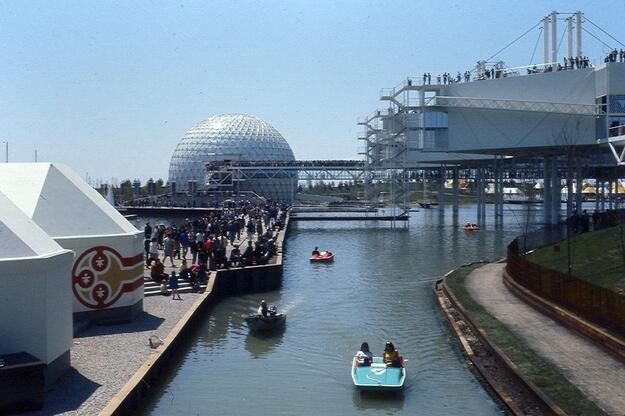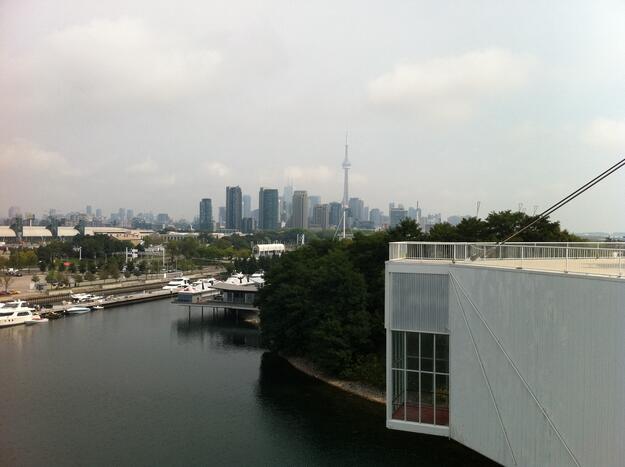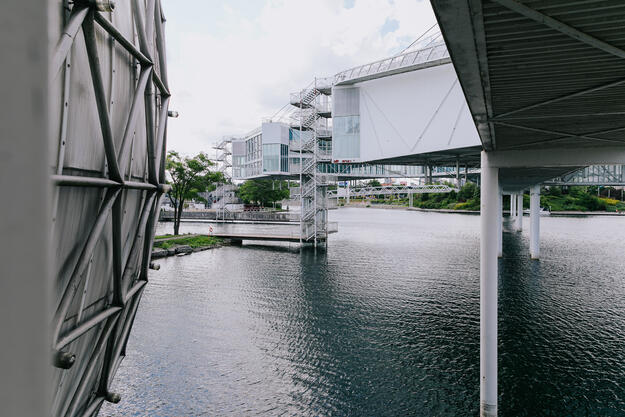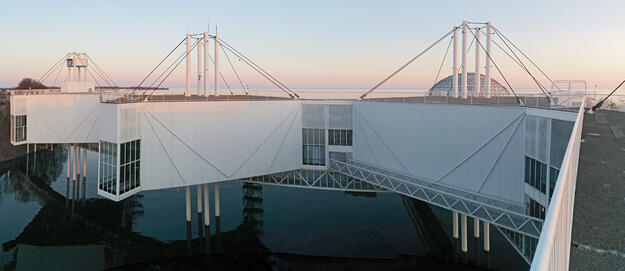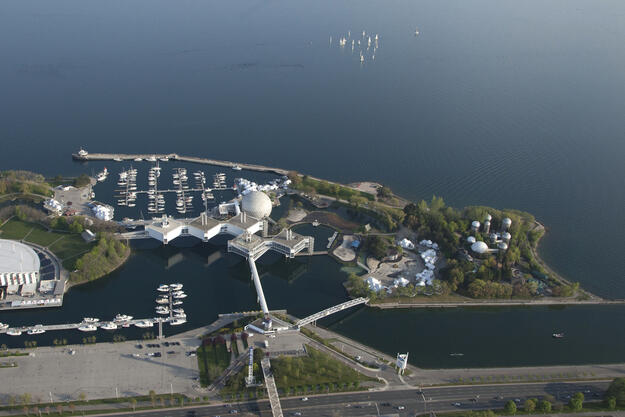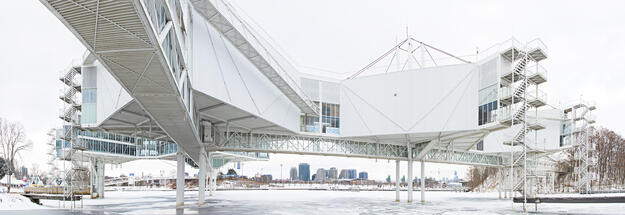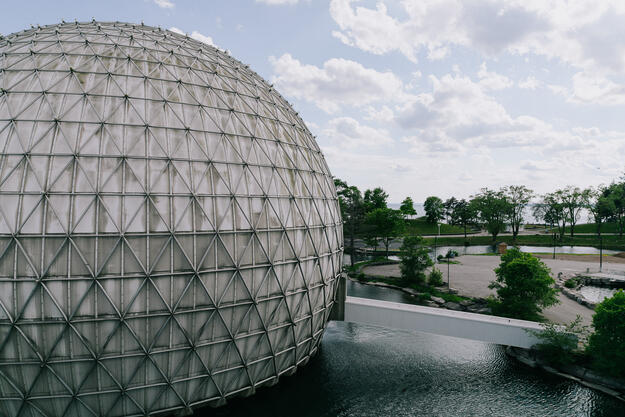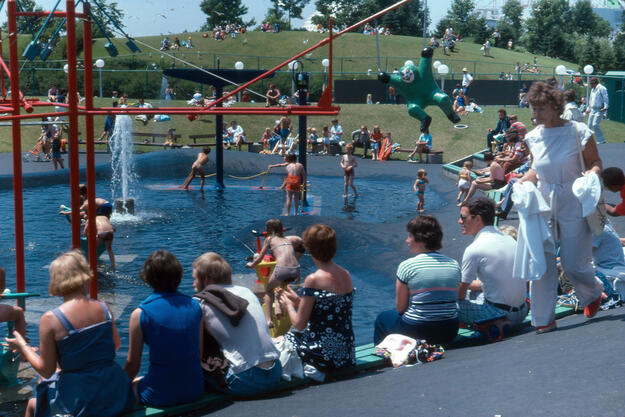Ontario Place
Site and Significance
A Modernist Icon
When it opened in 1971, Ontario Place gave Toronto’s citizens the opportunity to experience the city’s waterfront like they never had before. Creating a new urban amenity was envisioned as a celebration of Ontario’s cultural and economic achievement, in the spirit of civic competition, after Expo 67 captured the world’s attention on behalf of Toronto’s rival city of Montréal.
The design was entrusted to architect Eberhard Zeidler and landscape architect Michael Hough, who envisioned an expansive park on artificial islands rising out of Lake Ontario. Sheltered by a breakwater, in their midst they would contain the main attraction: a complex of five pods, each suspended above the surface of the water from a central pylon, and housing an exhibition showcasing the history of Canada. The adjacent Cinesphere was home to the world’s first permanent IMAX theater, while an open-air amphitheater, known as the Forum, hosted performing arts groups—from punk rock stars to the Toronto Symphony. Opening one year later, Children’s Village, an endlessly inventive play area created by designer Eric McMillan, quickly became an exhilarating attraction for the city’s youngest inhabitants.
Our Involvement
The 2020 World Monuments Watch
To the twenty-first-century observer, Ontario Place recalls a time when governments proudly invested in expanding access to the arts, education, health care, justice, and recreation. But after four decades of operation, the popularity of the lakefront park began to decline. Citing low numbers, the provincial government closed large portions of the site in 2011. In 2018 the governing board of Ontario Place was disbanded, opening the way to a call for redevelopment proposals from the private sector. The Ontario government now seeks to offer a long-term lease to the site, with little care for maintaining the heritage values associated with Ontario Place, and without public consultation that would allow citizens’ voices to be heard. In 2014 Ontario Place was added to the government’s List of Provincial Heritage Properties—but the province’s own statement of the site’s cultural heritage value is no longer available from the Ministry of Heritage, Tourism, Culture and Sport Industries.
In the 1960s and 1970s, Canadian architects and planners sought to use their talents to build a society based on social democratic values. The pluralistic culture that many of their contemporaries envisioned is now a reality in Toronto, which the BBC recently recognized as the world’s most diverse and multicultural city. The 2020 World Monuments Watch calls for an end to top-down decision-making and the embrace of heritage to encourage community dialogue. Through free and public access to the waterfront, Ontario Place can continue to foster interaction and exchange across population groups and fulfill the potential envisioned by its creators.
The Future of Ontario Place
In October 2020, WMF launched the Future of Ontario Place Project in collaboration with the John H. Daniels Faculty of Architecture, Landscape, and Design at the University of Toronto (Daniels Faculty) and Architectural Conservancy Ontario (ACO). This initiative aims to both grow awareness of the cultural landmark’s importance and to protect its future.
The Future of Ontario Place Project aims to safeguard the site’s landscape and built heritage from demolition and privatization, through a web portal and public campaign that will foster broader public recognition of the site. The website, Future of Ontario Place, is the first consolidated public resource on Ontario Place, and includes archival images and information, stories about the site collected from the general public, and interviews with architects, urbanists, activists, and current users about the significance of Ontario Place as a cultural and public asset for everyone.
With a mission to influence the government’s decision to redevelop the site and create a more open and productive dialogue between stakeholders, the project also includes a series of live debates on the current issues facing Ontario Place, facilitate an extensive letter writing campaign, and host a Canada-wide design challenge calling for alternative counterproposals for the site’s future in which the heritage values of Ontario Place are safeguarded and enhanced.
The Future of Ontario Place Project calls on the public and the community of architects, urbanists, and city builders to join the initiative in advocating for the protection of Ontario Place. Visit futureofontarioplace.org to share stories and experiences, and sign the letter to the Ontario government urging immediate action for the site’s protection.
Learn More
World Monuments Fund safeguards cultural heritage around the globe, ensuring our treasured places are preserved for present and future generations.
Sign up for our newsletter to receive regular updates on our projects, stories from the field, upcoming events, and more!
![]()

